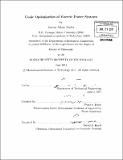| dc.contributor.advisor | Franz S. Hover. | en_US |
| dc.contributor.author | Taylor, Joshua Adam | en_US |
| dc.contributor.other | Massachusetts Institute of Technology. Dept. of Mechanical Engineering. | en_US |
| dc.date.accessioned | 2011-12-09T21:30:33Z | |
| dc.date.available | 2011-12-09T21:30:33Z | |
| dc.date.copyright | 2011 | en_US |
| dc.date.issued | 2011 | en_US |
| dc.identifier.uri | http://hdl.handle.net/1721.1/67601 | |
| dc.description | Thesis (Ph. D.)--Massachusetts Institute of Technology, Dept. of Mechanical Engineering, 2011. | en_US |
| dc.description | Cataloged from PDF version of thesis. | en_US |
| dc.description | Includes bibliographical references (p. 103-115). | en_US |
| dc.description.abstract | The electric power grid is recognized as an essential modern infrastructure that poses numerous canonical design and operational problems. Perhaps most critically, the inherently large scale of the power grid and similar systems necessitates fast algorithms. A particular complication distinguishing problems in power systems from those arising in other large infrastructures is the mathematical description of alternating current power flow: it is nonconvex, and thus excludes power systems from many frameworks benefiting from theoretically and practically efficient algorithms. However, advances over the past twenty years in optimization have led to broader classes possessing such algorithms, as well as procedures for transferring nonconvex problem to these classes. In this thesis, we approximate difficult problems in power systems with tractable, conic programs. First, we formulate a new type of NP-hard graph cut arising from undirected multicommodity flow networks. An eigenvalue bound in the form of the Cheeger inequality is proven, which serves as a starting point for deriving semidefinite relaxations. We next apply a lift-and-project type relaxation to transmission system planning. The approach unifies and improves upon existing models based on the DC power flow approximation, and yields new mixed-integer linear, second-order cone, and semidefinite models for the AC case. The AC models are particularly applicable to scenarios in which the DC approximation is not justified, such as the all-electric ship. Lastly, we consider distribution system reconfiguration. By making physically motivated simplifications to the DistFlow equations, we obtain mixed-integer quadratic, quadratically constrained, and second-order cone formulations, which are accurate and efficient enough for near-optimal, real-time application. We test each model on standard benchmark problems, as well as a new benchmark abstracted from a notional shipboard power system. The models accurately approximate the original formulations, while demonstrating the scalability required for application to realistic systems. Collectively, the models provide tangible new tradeoffs between computational efficiency and accuracy for fundamental problems in power systems. | en_US |
| dc.description.statementofresponsibility | by Joshua Adam Taylor. | en_US |
| dc.format.extent | 115 p. | en_US |
| dc.language.iso | eng | en_US |
| dc.publisher | Massachusetts Institute of Technology | en_US |
| dc.rights | M.I.T. theses are protected by
copyright. They may be viewed from this source for any purpose, but
reproduction or distribution in any format is prohibited without written
permission. See provided URL for inquiries about permission. | en_US |
| dc.rights.uri | http://dspace.mit.edu/handle/1721.1/7582 | en_US |
| dc.subject | Mechanical Engineering. | en_US |
| dc.title | Conic optimization of electric power systems | en_US |
| dc.type | Thesis | en_US |
| dc.description.degree | Ph.D. | en_US |
| dc.contributor.department | Massachusetts Institute of Technology. Department of Mechanical Engineering | |
| dc.identifier.oclc | 764478746 | en_US |
